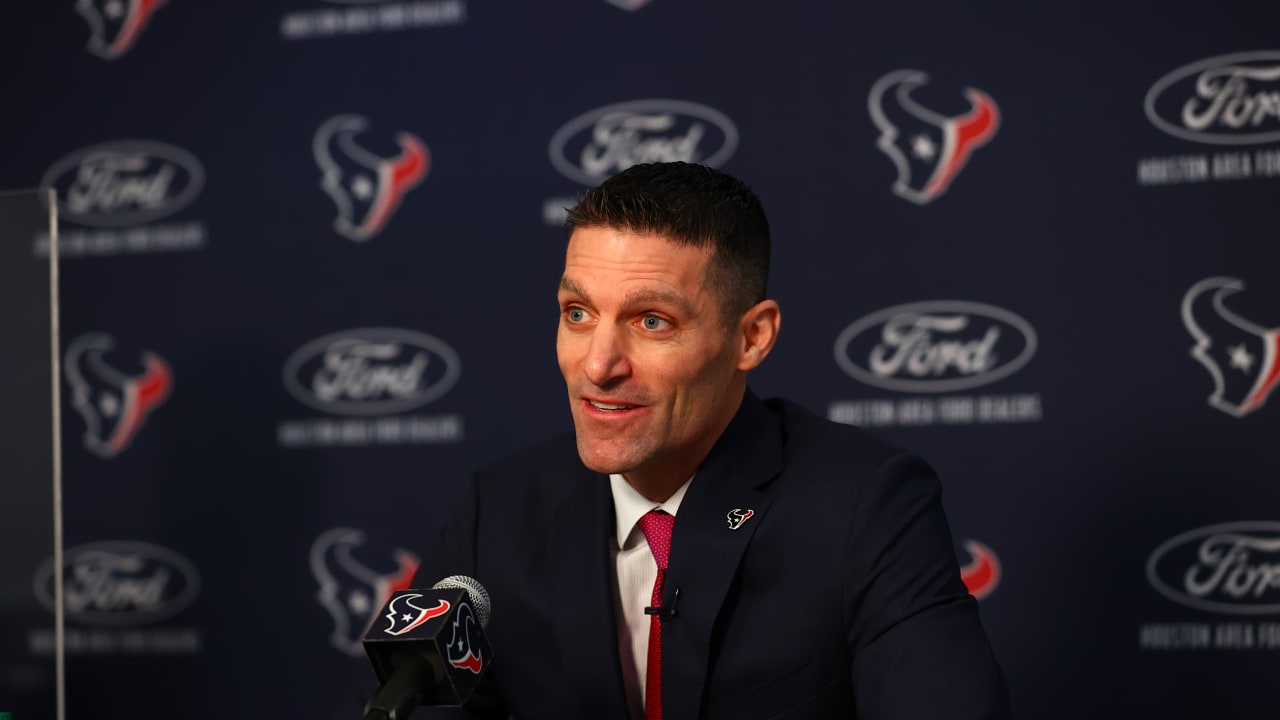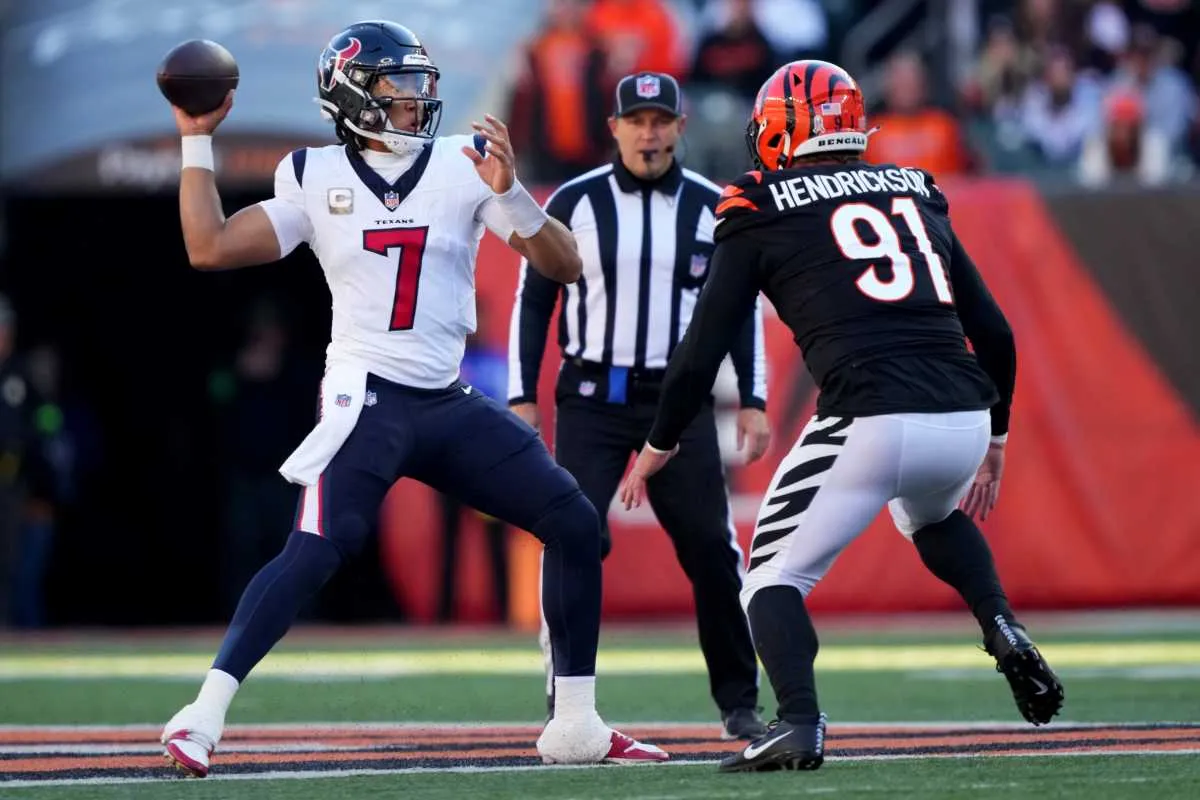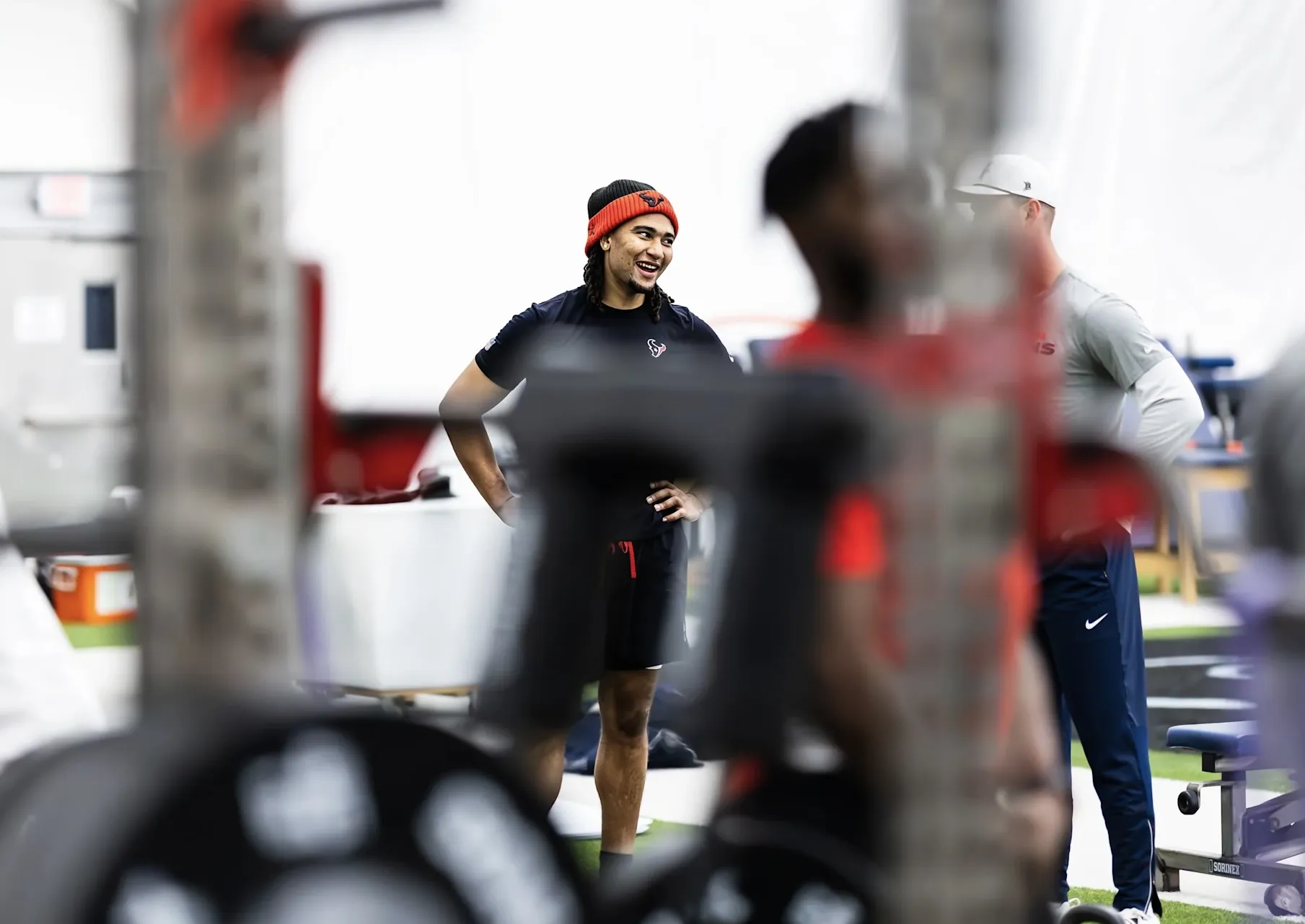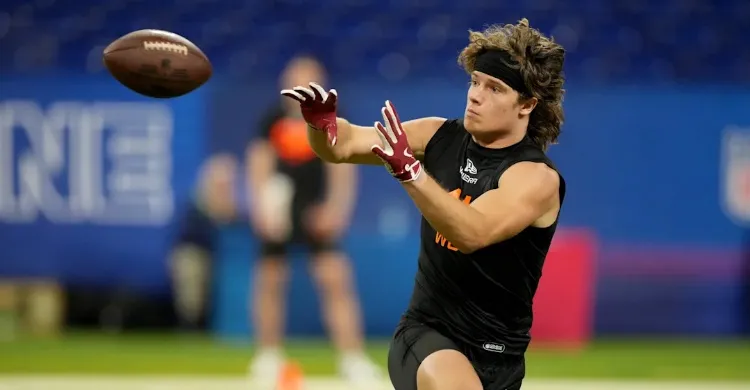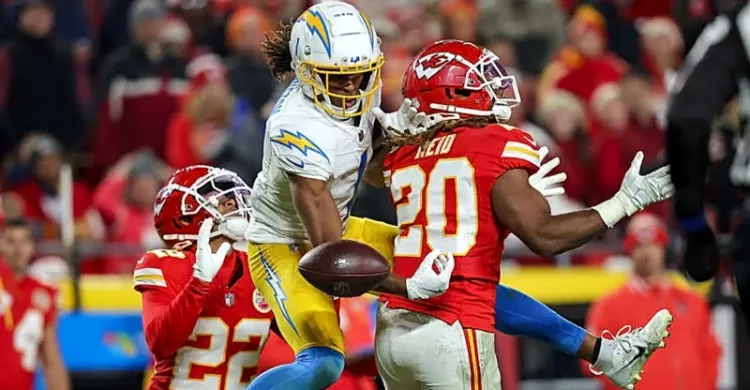For the first time since the NFL Scouting Combine, Houston Texans general manager Nick Caserio addressed the media ahead of next week's NFL draft. The Texans own seven picks, including four in the top 100.
Here were some of the key quotes from the 35-minute conversation at NRG Stadium.
Q: On if there is uncertainty with the far pick or confident enough in the group to be that far back
Nick Caserio: “Yeah, no, we're always prepared to pick. If we pick at 25, we're going to get a good football player. That's what we're focused on. Honestly, like we feel good about this Draft. There are players littered throughout the Draft, so we are pretty well positioned. Right now, we don't have a fourth-round pick. We got four in the top 89. Don't have a fourth, got a fifth, don't have a sixth, have two sevens. We'll have an opportunity. We think throughout the Draft to add players that we think are going to create some competition on this football team. I would say whoever we bring in being it's going to be hard to make this football team. Just trying to get the right players. We feel good about the players. Our board is probably smaller than some other boards and that's okay. There will be players to pick on Thursday and players to pick on Friday. Honestly, there will be players for us to pick on Saturday that we feel good about. Yeah, going to get a good player if we pick at 25. If we don't pick at 25, then wherever we pick next, we think we're going to get a pretty good player.”
Q: On if moves made in free agency gives the team more flexibility going into the Draft
Caserio: "We've never Drafted for need around here. Never going to. We're going to pick the best player we feel fits our program regardless of the position. I would say other than quarterback pretty much any position is on the table, like it always is. Try to stay true to the board. That's the reason we created the players. We put the players on the board, we grade them accordingly to what we think the role is going to be, then we take them off the board as we see fit. That's not going to change.”
Q: On thoughts about some of the talent in the Draft at the receiver position
Caserio: "Yeah, look, we think we have a good football team right now. The goal is to try to continue to add good football players. There are a number of players at that position that look like they're going to have an opportunity to help their team, so there is always a lot of factors involved in that system. What is their role, how are you going to use them? It's so hard to tell when you haven't been on the field yet. You just try to evaluate the player, see some of things you like on tape, things you don't like. Can you improve those areas maybe they're deficient? How do they fit with the rest of the group, what are we going to ask them to do? I think that's the one benefit of -- whether it's the visit here, interview at the Combine, you get more of an intimate understanding of what they were asked to do from an assignment and technique standpoint. You would hope they have an understanding of their assignment and system, and then we try to teach them some things relative to our system. How much they retain, they understand, where are they behind, where with is the gap we have to make up? I would say that position in particular in the Draft, certainly looks like there are some players that are going to be able to help teams, whomever Drafts them.”
Q: On the thought process with the changes on the offensive line
Caserio: "Yeah, I mean, honestly, it's the same every year. Every year is different. We understand there will be turnover on the team. There are certain players whose contracts will expire, some we'll keep, others are under contract and might be here and might not be here. We didn't go into the offseason and say, ‘Okay, here are the things we're going to do’. Some of this you have to be adaptable and flexible and take the information in and make the decisions you feel are best for the football team, which is what we did. So there is never a, ‘Well, this is what we're going to do, what we think is going to happen’. Some of that responded to the information around you and if we didn't make any changes, if we had to go into the season with the group that we had, then we would have done that. But that wasn't the case. Each case I would say was a little bit different. Each situation was a little bit different. But, yeah, I wouldn't say there was anything specifically we said there is what we're going to do and need to do. Then even moving forward, we feel good about the players in the building. Are we going to add some players we think can potentially help our football team? That's always the goal..
"We try to approach it the same way. We lost some players, moved on from some players at a lot of different positions. We've added some players at other players, including the offensive line. Once the players are here, once we have an opportunity get on the field, we'll see how it all fits together.”
Q: On what changes need to be made on the offensive line to get the results they are looking for
Caserio: "“Yeah, we always look at everything. You just try to, in the end, make the decisions that are in the best interest of the team. It's case by case. Each year will be a little bit different. Contracts are contracts. I mean, it's just part of the process. So we look at everything. If there is something we feel we can improve we'll look at that. If not, we keep moving forward. I don't think there is anything wholesale we feel like we have to do that much differently.”
Q: On how important was it to lock up players like CB Derek Stingley Jr. and S Jalen Pitre
Caserio: "Ee didn't do anything. The players earned those opportunities with their play and performance. You know, these are players that we think can help our football team moving forward. They certainly embody the quality we want the Houston Texans to look like. They are good football players, and our goal is to keep as many good football players around here as for as long a period of time as we can. It's a credit to the players and the coaches for putting themselves in that position. You know, I'll kind of handle the behind the scenes and the finances or the finance. But those players, I mean, they've all been here. Pitre has been here, Stingley has been here. Talk about going back to last year with Nico [Collins]. He's in here. I mean, so that says a lot about their commitment to winning and football, prioritizing their job and its importance. I think I got asked about this on 610 about once you give a player a contract, how are they going to respond. Are you worried about that relative to their approach and attitude? I would say not necessarily. If you got the right people, then in the end it's about them taking care of their personal situation and putting them in a position where they can take care of themselves and maybe future generations. That's the goal. We want to be put in a position to have an opportunity to potentially make an impact and help people. You know, it's kind of a different way, but this is a great way for them to be able to do that. In the end we want to go out there and play good football and that's what they're focused on.”
Q: On the difference in the evaluation process of a prospect that hasn't played a position but could change positions from what they did in college
Caserio: "There is a little bit of risk involved. There is risk in any player. I think when you see a player, whether it's play multiple positions, then it's a lot easier to say, you know what, we think he might be able to handle a multi-position role, whether it's offensively or defensively. The offensive line, OK, they just play tackle, can they move inside? They just played guard, can they put their hand on the ball and play center? If they haven't done it, you have to make an extrapolation based on the information you have.
"Same thing on defense. Have a corner. Never played inside the formation, do we think he can play inside the formation. Well, yeah. Here is the reason why. One thing about college football, you've seen multi-position players. Safeties playing nickel, corners playing nickel. All right, that maybe can enhance a player's overall value and try to project that into your system. What are you going to ask the player to do it ultimately it comes back to, and can they handle it? If they can handle it, great. If they can't, all right, just put them in a position where they can handle one specific thing. I would say going back to some of my experience in New England, [Julian] Edelman never played receiver. You're taking an absolute flyer on a player's traits and characteristics. He has never caught a punt, never caught a pass."
Q: On if it is more challenging to project the ceilings of players from smaller schools with the smaller sample size they have compared to players from big schools
Caserio: "I think the nature of the Draft in the end, there is a projection element regardless of how much a player has or has not played. When you're playing at ‘lower level,’ there is going to be an adjustment period that takes place. Is there an opportunity to evaluate that in the Senior Bowl or East West? I would say those two games did a pretty good job bringing in some lower-level, smaller-school players. It's a huge jump. No question about it. How are they going to handle it. Going back to [Kyle] Dugger, another example in New England, small school kid, playing against the 20 of us in this room. Basically nobody. And then at the Senior Bowl, and I'm including myself in that equation, went to the Senior Bowl and did okay. Is there some evidence along the way? Again, alright, here is the player. Here is what we think he does well. You might have to not downgrade it based on level of competition, but there is a little bit of a difference what the guy does against LSU versus against Western Tennessee State or somebody like that if that's who they're playing every week. You're not going to eliminate a player, but give him an opportunity, but not every player can make that jump. I mean, it's case by case like a lot of this is. There is a projection element involved, no question about it."
Q: On if it is more challenging to project the ceilings of players from smaller schools with the smaller sample size they have compared to players from big schools
Caserio: "I think the nature of the Draft in the end, there is a projection element regardless of how much a player has or has not played. When you're playing at ‘lower level,’ there is going to be an adjustment period that takes place. Is there an opportunity to evaluate that in the Senior Bowl or East West? I would say those two games did a pretty good job bringing in some lower-level, smaller-school players. It's a huge jump. No question about it. How are they going to handle it. Going back to [Kyle] Dugger, another example in New England, small school kid, playing against the 20 of us in this room. Basically nobody. And then at the Senior Bowl, and I'm including myself in that equation, went to the Senior Bowl and did okay. Is there some evidence along the way? Again, alright, here is the player. Here is what we think he does well. You might have to not downgrade it based on level of competition, but there is a little bit of a difference what the guy does against LSU versus against Western Tennessee State or somebody like that if that's who they're playing every week. You're not going to eliminate a player, but give him an opportunity, but not every player can make that jump. I mean, it's case by case like a lot of this is. There is a projection element involved, no question about it."
Q: On if it is more challenging to project the ceilings of players from smaller schools with the smaller sample size they have compared to players from big schools
Caserio: "I think the nature of the Draft in the end, there is a projection element regardless of how much a player has or has not played. When you're playing at ‘lower level,’ there is going to be an adjustment period that takes place. Is there an opportunity to evaluate that in the Senior Bowl or East West? I would say those two games did a pretty good job bringing in some lower-level, smaller-school players. It's a huge jump. No question about it. How are they going to handle it. Going back to [Kyle] Dugger, another example in New England, small school kid, playing against the 20 of us in this room. Basically nobody. And then at the Senior Bowl, and I'm including myself in that equation, went to the Senior Bowl and did okay. Is there some evidence along the way? Again, alright, here is the player. Here is what we think he does well. You might have to not downgrade it based on level of competition, but there is a little bit of a difference what the guy does against LSU versus against Western Tennessee State or somebody like that if that's who they're playing every week. You're not going to eliminate a player, but give him an opportunity, but not every player can make that jump. I mean, it's case by case like a lot of this is. There is a projection element involved, no question about it."
